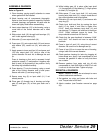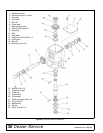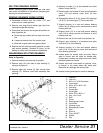
Owner Service 25
MAN0390 (Rev. 4/6/2007)
SHIELDING REPAIR
Full chain or rubber shielding is required for all
non-agricultural mowing. Full shielding is also rec-
ommended for all agricultural use to further reduce
the risk of thrown objects.
Repairing Rubber Shielding
Inspect belting and rear bands each day of operation
and replace if bent, cracked, or broken.
Repairing Optional Chain Shielding
Inspect chain shielding each day of operation and
replace any broken or missing chains as required.
CLEANING
After Each Use
● Remove large debris such as clumps of dirt, grass,
crop residue, etc. from machine.
● Inspect machine and replace worn or damaged
parts.
● Replace any safety decals that are missing or not
readable.
Periodically or Before Extended Storage
● Clean large debris such as clumps of dirt, grass,
crop residue, etc. from machine.
● Remove the remainder using a low-pressure water
spray.
1. Be careful when spraying near scratched or torn
safety decals or near edges of decals as water
spray can peel decal off surface.
2. Be careful when spraying near chipped or
scratched paint as water spray can lift paint.
3. If a pressure washer is used, follow the advice of
the pressure washer manufacturer.
● Inspect machine and replace worn or damaged
parts.
● Sand down scratches and the edges of areas of
missing paint and coat with Woods spray paint of
matching color (purchase from your Woods
dealer).
● Replace any safety decals that are missing or not
readable (supplied free by your Woods dealer).
See Safety Decals section for location drawing.
SERVICING TIRES SAFELY
Used Aircraft Tires (Figure 17)
Do not attempt to mount a tire unless you have the
proper equipment and experience to perform the job.
Always maintain the correct tire pressure. Do not inflate
tires above the recommended pressure. Never weld or
heat a wheel and tire assembly. The heat can cause an
increase in air pressure and result in a tire explosion.
Welding can structurally weaken or deform the wheel.
When inflating tires, use a clip-on chuck and an exten-
sion hose long enough to allow you to stand to the side
— not in front of or over the tire assembly. Use a safety
cage if available.
Check wheels for low pressure, cuts, bubbles, dam-
aged rims, or missing lug bolts and nuts.
Never remove split rim assembly hardware (A) with the
tire inflated.
Figure 17. Split Rim Tire Servicing
WARNING
A
DECAL PN 1006348
(Rev. 2/6/2009)


















